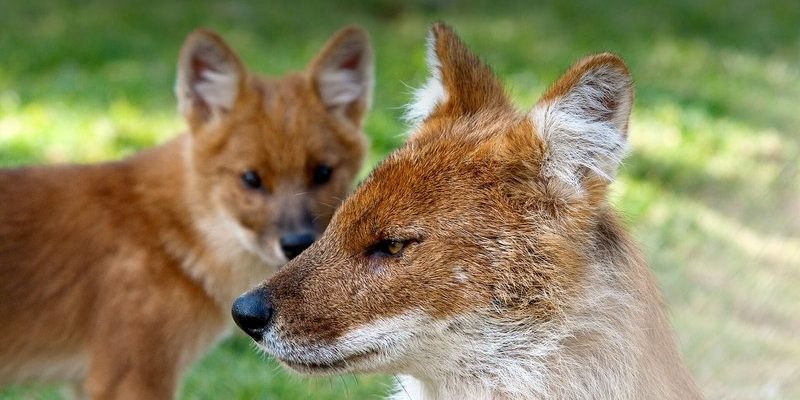![Comparing The Dhole Vs. [Similar Species]](https://gudri.com/wp-content/uploads/2025/06/Comparing_The_Dhole_Vs___Similar_Species__image_0.jpg)
Imagine sitting with a friend, discussing how these two species operate in their environments. Both the dhole and the African wild dog are expert hunters, known for their pack behavior, which is a lot like how a well-coordinated team works together to achieve a common goal. But how do their physical traits, habitats, and lifestyles compare? Grab your mocha frappuccino while we break it down!
Physical Characteristics
Both the dhole and African wild dog come with their own unique looks, which help them thrive in their respective environments. The dhole typically weighs between 30 and 50 pounds and sports a rich, rusty-red coat that allows it to blend into the forests of Asia. Its slender build and long legs make it agile, perfect for sprinting through dense terrain. On the other hand, the African wild dog packs a bit more weight—ranging from 40 to 75 pounds—along with a spotted coat that varies in color, including yellows, browns, and whites. This camouflage helps them hide effectively in the savannah.
Both species have large, rounded ears that enhance their hearing abilities. Imagine being able to pick up the faintest sounds of rustling grass, which is crucial for their survival. Their tails are another interesting feature; the dhole has a bushy tail that aids in balance, while the African wild dog’s tail acts like a flag, helping pack members keep track of each other during a hunt.
Social Structures
Now, let’s talk about social life. The dhole is known for its strong pack dynamics; typically, a pack consists of 5 to 12 members, led by a dominant pair. These packs work like a well-oiled machine, cooperating to hunt and raise their young. They might remind you of a close-knit family working together for a common goal.
On the flip side, the African wild dog is even more communal. A pack can range from 2 to 27 dogs! They also exhibit a high level of cooperation, often sharing food with one another after a successful hunt. Here’s the thing: they have a fascinating ritual known as “greeting ceremonies,” where they engage in playful behavior upon returning from a hunt, reinforcing their bonds. This strong social structure might make you think of a large family reunion where everyone shares laughter and stories.
Hunting Strategies
When it comes to hunting, both the dhole and African wild dog showcase their talents. The dhole primarily hunts in the early morning or late evening, relying on stamina to chase down prey. They often target larger animals, like deer and wild boar, working together to wear down their quarry.
African wild dogs, meanwhile, have a different approach. Their strategy is all about teamwork and speed. They often utilize a method called “relay hunting,” where they take turns chasing prey to exhaust it. This is a lot like a marathon relay race, with each dog sprinting in short bursts to take the lead. It’s impressive to watch, and it’s a major reason why they have such high success rates compared to solitary hunters.
Habitat and Range
The habitats of these two fascinating species also tell a story. The dhole is primarily found in Asia, ranging from India to Southeast Asia. They prefer forested areas, grasslands, and scrub, usually staying away from human settlements. Think of them as shy introverts, enjoying the quiet comfort of the woods.
Conversely, the African wild dog roams the savannahs and open woodlands of sub-Saharan Africa. Their habitat is more open, allowing them to use their speed and teamwork effectively. This is much like an athlete performing on a wide, open field where they can showcase their skills.
Conservation Status
Sadly, both species face significant threats. The dhole is considered endangered, primarily due to habitat loss and competition with other predators like lions and tigers. Efforts to protect their habitats are crucial for their survival. It’s like trying to save a beloved childhood book from being tossed away—once it’s gone, it’s gone for good.
On the other hand, African wild dogs are classified as vulnerable. Their populations have been declining due to habitat fragmentation, human encroachment, and disease. Conservation efforts, such as creating protected areas and wildlife corridors, are essential to ensuring they don’t vanish, much like protecting a rare plant in a garden.
Both the dhole and the African wild dog offer us a peek into the rich tapestry of wildlife. While they share some similarities—like their pack behaviors and hunting tactics—they are also distinctly unique in their appearance, habitats, and social structures. Understanding these differences helps us appreciate the complexities of nature and the importance of protecting these incredible species.
So next time you see a dog, whether it’s your loyal pet or a wild counterpart, remember the fascinating connection between them all. Let’s continue to celebrate and protect the entire family of wild canids, ensuring they thrive for generations to come.

